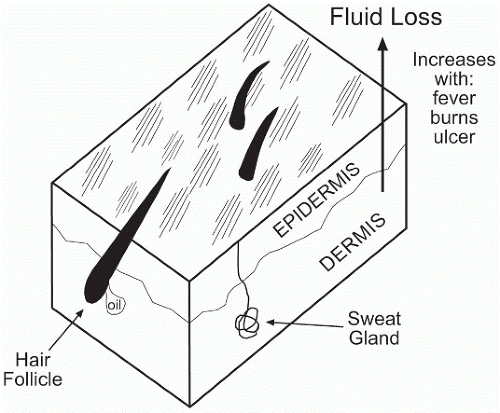Skin as a Barrier to Fluid Loss
QUICK LOOK AT THE CHAPTER AHEAD
Part of the integumentary system, the skin is the largest organ in the body, protecting the musculoskeletal structure and internal organs. In this chapter we discuss the qualities of skin and how fluid is lost through the skin.
The skin is the largest organ in the body, protecting the musculoskeletal structure and internal organs. The skin, hair, nails, glands, and nerves, known as the integumentary system, make up an intricate structure that helps to regulate body temperature, fluid loss, production of vitamin D, and microbial defense. It comprises 20% of the body’s weight. The skin has an elastic quality that allows for stretching. It is thick and tough in some areas, such as the palms of the hands and soles of the feet, and smooth and silky in others, such as the mucous membranes of the mouth and eyelids.
Along with its many other functions the skin is waterproof, yet it allows for perspiration to help regulate body temperature. Through its peripheral thermoreceptors, the skin has an ability to trigger the hypothalamus for heat production and conservation when the temperature is low and
evaporation when the temperature is hot. An increase in perspiration through the skin surface and mucous membrane linings aids in body water evaporation. Excessive perspiration, however, can affect the body’s fluid balance and electrolyte status.
evaporation when the temperature is hot. An increase in perspiration through the skin surface and mucous membrane linings aids in body water evaporation. Excessive perspiration, however, can affect the body’s fluid balance and electrolyte status.
Burns can cause a rapid fluid loss through the skin. Fluid seeps out of open skin and also seeps into the tissues. The amount of protein loss affects the loss of fluid. With the loss of protein, altered colloid osmotic pressure, and increased capillary permeability, fluid shifts, causing edema.
Question: How do burns cause a fluid shift in the body?
View Answer
Answer: When protein is lost through leaky capillaries, the colloidal osmotic pressure is no longer able to pull fluid back into the capillary, resulting in a loss of fluid.
Pressure ulcers and fistulas also affect water loss. Pressure sores form in vulnerable patients with compromised peripheral circulation or the inability to move and change positions normally. Compressing the skin so that the capillary pressure exceeds 25 mm Hg occludes blood vessels in the tissue. Frequent repositioning helps to relieve this pressure, but when repositioning is not performed ulcers begin to form. Constant weeping from large pressure ulcers and fistulas can affect the body’s fluid balance.
Trauma such as deep puncture wounds, facial lacerations, and open compound fractures cause an opening in the skin for blood loss. Major trauma can affect the body’s fluid balance until replacement fluid has been administered and the skin repaired.
PART IV • QUESTIONS
1. One of the major hormones released by the hypothalamus/ pituitary is
(A) Renin
(B) ADH
(C) ANP
(D) Creatine
View Answer
1. The correct answer is B. Rationale: ADH is released by the hypothalamus/posterior pituitary in response to an increased osmolality. Renin is initiated by the renal system in response to a need for vasoconstriction. ANP is synthesized in the atrium of the heart in response to an increased fluid volume. Creatine is a byproduct of muscle catabolism.
2. The descending limb of the loop of Henle is readily lowbar to water and the ascending limb of the loop of Henle is lowbar to water.
(A) Permeable/impermeable
(B) Impermeable/permeable
3. Which of the following systems is the quickest responder to an acid-base imbalance?
(A) Renal system
(B) Protein buffering system
(C) Phosphate buffering system
(D) Respiratory system
View Answer




3. The correct answer is B. Rationale: Proteins are the largest system for buffering, acting as either an acid or a base, and are immediately available to combine to either excess acid or base imbalances in the body. The respiratory system is a fast responder to an acid-base imbalance through its ability to expel carbon dioxide. The renal system is the slowest, taking days to weeks. The phosphate buffering system works best when the renal tubular fluid is flooded with excess H+ ions.
Stay updated, free articles. Join our Telegram channel

Full access? Get Clinical Tree


Get Clinical Tree app for offline access



